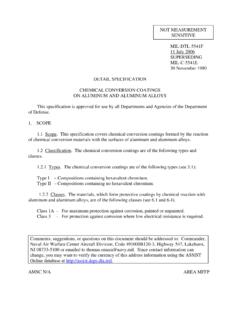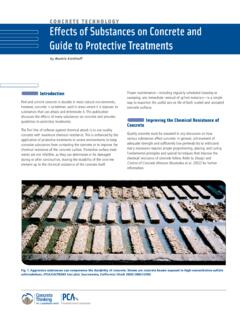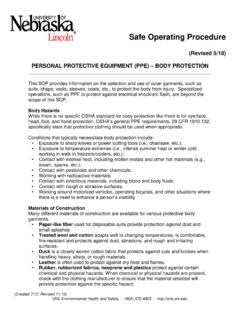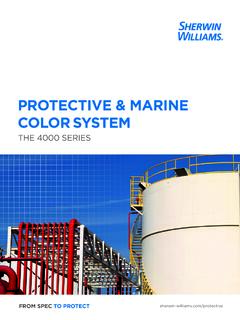Transcription of Handbook for Corrosion Protection - Teknos
1 Handbook for Corrosion Protectionof Steel Surfaces by PaintingHandbook for Corrosion Protectionof Steel Surfaces by Painting4 2013, Teknos Oy (Second Edition)Publisher: Teknos OyLayout design: Mainostoimisto Dynastia OyPrinters: Offsetpaino Tuovinen KyAcknowledgements:Pinteco Oy (Elcometer)Tallberg Roboma Oy Ab (DeVilbiss, Ransburg, Binks) Str mberg Oy (Byk)Photographs on the inside covers:Sandvik Mining and ConstructionAvant TecnoPonsseVRNormek, Sonera StadiumRuukki, Swedbank StadiumNeste OilWinWind45 Corrosion Protection by paint systemsPaints are liquid or powdery substances that are applied in thin coats on a substrate using a paint application method. The paint dries into a solid coating which bonds to the painting of metal substrates with protective paint systems is called Corrosion Protection purpose of Corrosion Protection painting is to protect the metal substrate against atmospheric corrosivity, rust, and to give the surface the designed appearance and Protection painting is a process where quality cannot be fully assessed merely based on the ac-ceptance inspection of the finished coating.
2 Therefore, it is imperative that the process of Corrosion Protection painting is planned carefully. It is equally important to manage and monitor all parameters affecting the coating outcome during the painting has compiled this Handbook to provide clients, designers, employees and students with optimally com-prehensive information on Corrosion Protection hope that you will find this Handbook useful. Yours faithfully, Teknos OY6 Corrosion Protection painting1. protective PAINTING AS Corrosion Protection METHOD ..9 Introduction ..9 Corrosion mechanism in metals ..9 Protection mechanism of paint systems ..10In conclusion ..102. PRIMARY STANDARDS ASSOCIATED WITH Corrosion Protection PAINTING ..11 Standardisation ..11EN and ISO standards ..113. PLANNING OF Corrosion Protection PAINTING ..16 Prerequisites for good Corrosion Protection painting ..16 Painting as design consideration for steel structures.
3 16 Determination of application site for Corrosion Protection painting ..174. SUBSTRATE PREPARATION ..18 Determination of preparation method and the quality grade for metal working and surface preparation ..18 Removal of grease and soil ..18 Rust removal ..18 Determination and assessment of cleanliness and surface profile of steel surface ..19 Rust grades ..19 Preparation grades ..19 Grading of blast-cleaned steel surface profile ..20 Prefabrication primer treatment ..22 Preparation of galvanised surfaces ..22 Chemical conversion treatments and etching primers ..23 5. protective PAINT SYSTEMS ..25 Composition of paints ..25 Paint types ..26 Reversible coatings ..26 Irreversible coatings ..26 Air curing paints (oxidation) ..26 Water-borne dispersion paints (one-pack) ..27 Chemically curing paints ..27 Two-pack epoxy paints EP ..27 Two-pack polyurethane paints PUR.
4 27 Oxirane ester paints .. 28 Moisture curing paints ..28 Stoving paints ..28 Powder coatings ..28 Coil coatings ..28 6. PAINT SYSTEMS ..29 Markings of the paint systems ..29 Determination of the paint system ..30 Corrosivity categories ..30 Preparation and application conditions ..30 Economical considerations ..30677. EXECUTION OF PAINT Painting methods ..31 Brush application ..31 Roller application ..31 Spraying ..31 Dipping ..37 Application conditions ..37 Relative humidity and dew point ..37 Effect of ambient temperature on curing ..40 Film thickness and associated measurement ..40 Film thickness ..40 Measurement of wet film thickness ..40 Measurement of dry film thickness ..41 Non-destructive methods ..41 Destructive methods ..42 Calculation of paint consumption ..43 Tables for estimation of paint consumption.
5 448. QUALITY CONTROL OF Corrosion Protection PAINTING ..45 Quality plan ..46 Targets of quality assurance ..46 Personnel ..46 Steel structure ..47 Surface preparations ..47 Conditions ..47 Application methods, tools and implements ..48 Substances used in paint work ..48 Application ..48 Finished coating ..48 Inspection tools and implements ..49 Reference areas ..49 Documentation of paint work and conditions ..49 Documents existing prior to commencement of paint work ..49 Documents issued during paint work ..49 Inspection records ..499. MAINTENANCE PAINTING ..51 Evaluation of coating degradation ..51 Time for maintenance painting ..51 Determination of the maintenance paint ..52 Execution of maintenance painting ..5310. OCCUPATIONAL SAFETY GUIDELINES APPLICABLE TO PAINT WORK ..5411. LIST OF STANDARDS ..5612. PAINTING PROBLEMS TROUBLESHOOTING.
6 6013. FUTURE OF Corrosion Protection PAINTING ..63 FORMS ..658891. protective painting as Corrosion Protection methodIntroductionVarious engineered materials used for industrial purposes require Protection against the effects of the environ-ment. These materials comprise concrete composites and a number of different metals, for example. Con-crete substrates need coating against carbonatisation and surface disintegration due to abrasion, among others things. Metals need Protection against is a physicochemical reaction occurring when a metal is exposed to its environment, which changes the properties of the metal and, in many cases, results in degradation of the metal, adjacent environment or technical is reaction product of iron and steel damage is any change in the Corrosion system due to Corrosion and which is considered to cause degradation of the metal, the adjacent environment, or the technical system they constitute system comprises one or multiple metals and all of the parameters of the environment, which contrib-ute to Corrosion .
7 Such parameters of the environment can also be the coating surface layer, electrode, and so forth. Anti- Corrosion or Corrosion Protection refers to the modification of the Corrosion system in a way that retards or inhibits the formation of Corrosion Protection painting refers to the coating of metal surfaces with Corrosion Protection mechanism in metalsMetal Corrosion is currently explained by the formation of local electrochemical electrode pairs on the metal sur-face. The electrode pair is called an anode-cathode pair. Positive metal ions are dissolved from the anode to the solution, and produce negative electrons in the metal lattice, which migrate in the metal to the cathode. In the cathode, the electrons are consumed in multiple cathode reactions. In acid solutions, hydrogen gas is produced, while in pH neutral solutions oxygen reduction produces hydroxide ions.
8 The electrically conductive electrolyte between the anode and cathode closes the circuit. The anode and cathode sites can be next to one another, resulting in the formation of uniform Corrosion or separated from one another resulting in localised Corrosion . The anode site is the metal surface s less noble site or a site with a higher surface energy. Image illustrates the formation of local pairs onto a metal surface, and the anode and cathode The formation of local pairs onto a metal surface, and the anode and cathode Corrosion pairs(-) anode Fe > Fe2+ + 2e-(+) cathode 2H+ + 2e- > H2O2 + 2H2O + 4e- > 4OH-10 Combining the anode and cathode reactions provides the total reaction:Fe2+ + 2OH- > Fe(OH)2 4Fe(OH)2 + O2 > 2H2O + 2Fe2O3*H2O hydrous iron oxide, rustThe Corrosion Protection mechanism in metal is based on- the inhibition of formation of local pairs on a metal surface, and- the inhibition or retardation of anode and/or cathode reactionProtection mechanism of paint system The overwhelmingly most popular Corrosion Protection method is the application of paint onto the metal surface.
9 An impervious, intact and sufficiently thick coating will prevent ions from entering the metal surface, thus reduc-ing the formation of local pairs. Epoxy paints provide an example of a type of paint based on Protection paints used against atmospheric stress utilise Corrosion Protection pigments, which retard the dissolution of metal ions from the anode sites. Various phosphates and borates, for example, are used as Corrosion Protection pigments, which, together with water entering the coating, form protective layers at the anode sites. The paint protects the steel surface cathodically, when it contains sufficient quantity of zinc dust. The zinc parti-cles in the coating are in electrically conductive contact with the steel substrate, and, as electronegative metals, are sacrificial anodes that inhibit steel paints also utilise Corrosion inhibitors to inhibit Corrosion during paint application or curing (flash rust).
10 In conclusionCorrosion of the metal surface to be protected can be inhibited or retarded by applying:- Corrosion Protection paint containing Corrosion Protection pigments, which passivates the anode and/or cathode reaction, or- a coating, which generates sufficient resistance against an ion current- a primer giving cathodic protection10112. Primary standards associated with Corrosion Protection paintingStandardisationThe purpose of standards is to promote trade and industry, increase safety, welfare and consumer Protection as well as to facilitate domestic and cross-border to standard EN 45020, the standard resulting from standardisation work is defined as follows: A standard is a normative document, established by consensus and approved by a recognised body, that pro-vides for common and repeated use, rules, guidelines, or characteristics for activities or their results, aimed at the achievement of the optimum degree of order in a given content.








